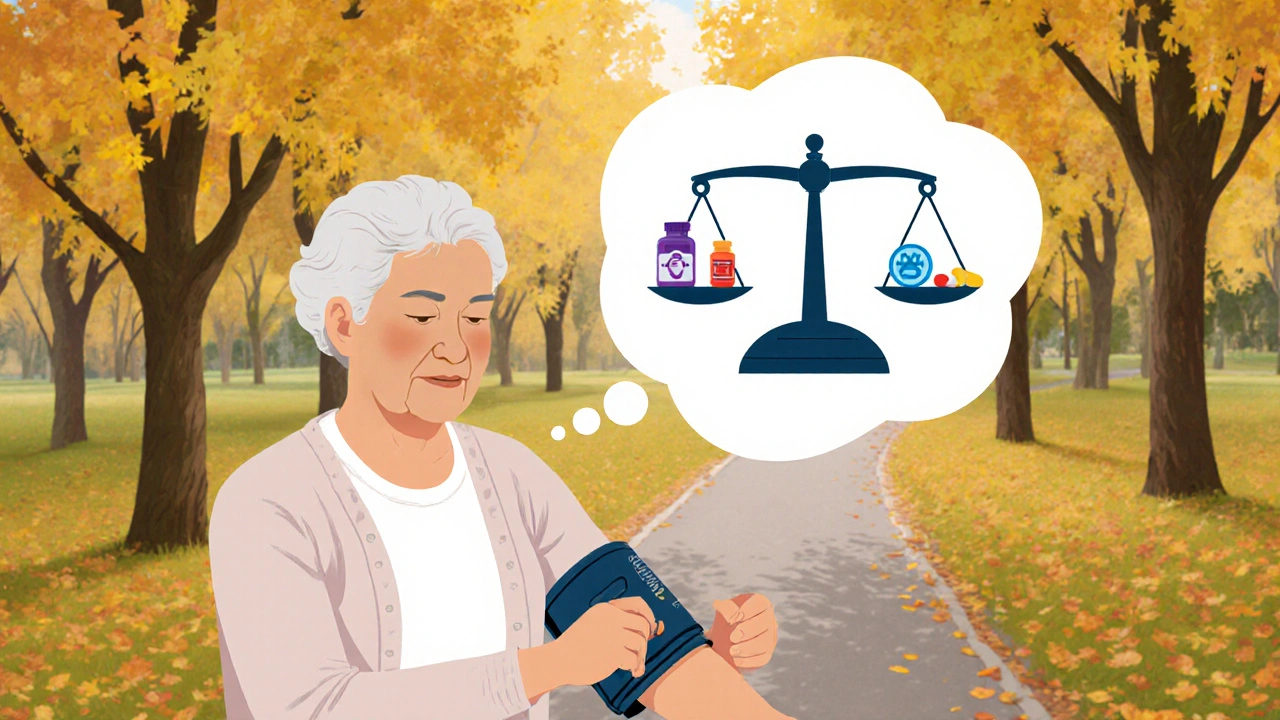Candesartan (Atacand) vs Other ARBs: Which Blood Pressure Drug Is Right for You?

ARB Medication Comparison Tool
Select your preferences below to compare ARB medications:
Recommended ARB Medication
Quick Take
- Atacand (Candesartan) is an ARB with a long half‑life and strong evidence for protecting the heart.
- Losartan, Valsartan, Irbesartan, Telmisartan and Olmesartan are the most common ARB alternatives.
- ACE inhibitors such as Lisinopril work upstream in the same pathway but cause more cough.
- Side‑effect profiles are similar; differences lie in dosing convenience, drug‑interaction risk and price.
- Choosing the right drug depends on kidney function, pregnancy status, cost considerations and personal tolerability.
Atacand is a angiotensin II receptor blocker (ARB) that lowers blood pressure by blocking the AT‑1 receptor, characterized by a half‑life of about 9hours, once‑daily dosing (8‑32mg), and contraindication in pregnancy. Clinical trials (e.g., the Candesartan in Heart failure Assessment of Reduction in Mortality and morbidity - CHARM) showed a 23% reduction in cardiovascular death for heart‑failure patients.
How Atacand Works in the Renin‑Angiotensin‑Aldosterone System
The renin‑angiotensin‑aldosterone system (RAAS) regulates blood‑volume and vessel tone. Renin converts angiotensinogen to angiotensinI; ACE then turns it into angiotensinII, which binds AT‑1 receptors causing vasoconstriction and sodium retention. Candesartan blocks that final step, preventing the pressor effect without affecting bradykinin - the reason ARBs spare patients from the dry cough common with ACE inhibitors.
Key Clinical Attributes of Atacand
- Typical starting dose: 8mg once daily; max: 32mg.
- Half‑life: 9hours, but active metabolite extends duration to 24hours.
- Renal clearance: 30% unchanged; dose adjustment needed for eGFR <30mL/min.
- Common side‑effects: dizziness, hyperkalemia, mild headache.
- Contraindications: pregnancy, bilateral renal artery stenosis, severe hepatic impairment.
Most Frequently Used ARB Alternatives
Below are the five ARBs most often prescribed alongside Atacand. Each shares the same mechanism but differs in potency, pharmacokinetics and cost.
Losartan is the first‑in‑class ARB, approved in 1995, taken 50‑100mg daily, with a 2‑hour half‑life and active metabolite lasting 6‑9hours.
Valsartan offers 4‑hour half‑life, typical dose 80‑320mg daily, and is often combined with hydrochlorothiazide for added diuretic effect.
Irbesartan is favored in patients with diabetic nephropathy; standard dose 150‑300mg daily, half‑life 11‑15hours.
Telmisartan has the longest half‑life of the group (24hours), allowing flexible dosing; common dose 40‑80mg daily, and it has modest PPAR‑γ activity that may improve insulin sensitivity.
Olmesartan is a potent AT‑1 blocker, dose 20‑40mg daily, half‑life 13hours; rare cases of sprue‑like enteropathy have been reported.
Comparison Table: Atacand vs Other ARBs
| Drug | Typical Daily Dose | Half‑Life (hrs) | Active Metabolite? | Unique Feature |
|---|---|---|---|---|
| Candesartan | 8‑32mg | 9 (active metabolite extends to 24) | Yes | Strong evidence in heart‑failure mortality reduction |
| Losartan | 50‑100mg | 2 (active metabolite 6‑9) | Yes | First‑in‑class, well‑studied renal protection |
| Valsartan | 80‑320mg | 4 | No | Commonly paired with thiazide diuretics |
| Irbesartan | 150‑300mg | 11‑15 | No | Preferred for diabetic kidney disease |
| Telmisartan | 40‑80mg | 24 | No | PPAR‑γ activity, potential metabolic benefits |
| Olmesartan | 20‑40mg | 13 | No | Rare sprue‑like enteropathy warning |

Choosing the Right ARB for You
When a doctor prescribes an ARB, they weigh several practical factors:
- Kidney function: Patients with eGFR <30mL/min may need a lower dose of Candesartan or switch to Irbesartan, which has a gentler renal profile.
- Cost and insurance coverage: Generic Losartan and Valsartan are often cheaper than brand‑name Candesartan; however, bulk‑price programs in Australia have narrowed the gap for Atacand.
- Pregnancy considerations: All ARBs, including Candesartan, are category X - they must be stopped before conception. ACE inhibitors share the same restriction.
- Co‑medications: If a patient already takes a potassium‑sparing diuretic, Telmisartan’s longer half‑life may increase hyperkalaemia risk, making Candesartan a safer choice because its active metabolite is less prone to potassium accumulation.
- Specific comorbidities: For diabetic nephropathy, Irbesartan has dedicated outcome data; for heart‑failure with reduced ejection fraction, Candesartan’s CHARM results give it an edge.
Side‑Effect Profile Across the ARB Family
Overall, ARBs share a low‑incidence side‑effect spectrum. The most common complaints are dizziness, headache and mild fatigue. Below is a quick side‑effect map linking each drug to a notable signal.
- Candesartan - occasional hyperkalaemia, especially with ACE‑inhibitor overlap.
- Losartan - rare angio‑edema (≈0.1%); beneficial effect on uric acid levels.
- Valsartan - modest increase in serum creatinine in patients with pre‑existing renal impairment.
- Irbesartan - good tolerability in diabetics, minimal impact on glucose.
- Telmisartan - possible mild gastrointestinal upset due to longer exposure.
- Olmesartan - watch for chronic diarrhea & weight loss; a sprue‑like syndrome reported in <1% of long‑term users.
If any side‑effect becomes persistent, switching to another ARB is usually safe because cross‑reactivity is low.
Cost and Access in Australia
Australian Pharmaceutical Benefits Scheme (PBS) lists Atacand 4mg tablets at a concessional price of about AUD15 per month, while generic Losartan is PBS‑listed at roughly AUD8. Valsartan and Irbesartan are similarly priced to Losartan. Telmisartan and Olmesartan, being newer, sit around AUD25‑30 monthly unless covered by a private health plan. Pricing fluctuations mean it pays to check the latest PBS schedule before finalising a prescription.
Related Concepts: ACE Inhibitors and Calcium‑Channel Blockers
While ARBs dominate the modern hypertension market, they exist alongside other major classes. Lisinopril is a widely used ACE inhibitor that reduces angiotensin‑II formation upstream. Its hallmark side‑effect is a persistent dry cough, affecting up to 10% of patients, which often drives a switch to an ARB like Candesartan.
Calcium‑channel blockers (e.g., Amlodipine) act on vascular smooth muscle instead of the RAAS, providing an additive effect when combined with ARBs. The 2023 Australian Hypertension Guidelines recommend a dual approach-ARB plus CCB-for patients whose blood pressure stays above 150/95mmHg despite monotherapy.
Practical Tips for Patients Starting an ARB
- Take the tablet at the same time each day, preferably in the morning.
- Check potassium levels after 2 weeks, especially if you’re on a potassium‑rich diet.
- Stay hydrated; dehydration can exaggerate the blood‑pressure‑lowering effect.
- If you miss a dose, take it as soon as you remember unless it’s near the next scheduled dose.
- Report any swelling of the face, lips or tongue immediately-rare but serious angio‑edema can occur.
Next Topics to Explore
Now that you understand how Candesartan measures up against its peers, you might want to dive deeper into:
- Long‑term outcomes of ARBs in chronic kidney disease.
- Combination therapy strategies for resistant hypertension.
- Pharmacogenomics: How genetic variations affect ARB response.

Frequently Asked Questions
Can I switch from Losartan to Candesartan without a washout period?
Yes. Both drugs are ARBs and share the same target receptor. A direct switch on the same day is safe, but you should monitor blood pressure and potassium for a week after the change.
Is Candesartan better for heart‑failure patients than other ARBs?
The CHARM program showed a statistically significant reduction in cardiovascular death for Candesartan‑treated heart‑failure patients, a benefit that is modestly stronger than the data for Losartan or Valsartan. However, individual response varies, so clinicians weigh overall risk profile.
What should I do if I develop a persistent cough on an ACE inhibitor?
Switching to an ARB such as Candesartan usually resolves the cough within a few days because ARBs do not increase bradykinin levels, the main culprit behind ACE‑inhibitor cough.
Are there any diet restrictions while taking Candesartan?
No strict bans, but keep a moderate potassium intake. Foods like bananas, oranges and tomatoes can raise serum potassium, which may be problematic if you already have borderline hyperkalaemia.
How does Telmisartan’s PPAR‑γ activity affect diabetes risk?
Telmisartan modestly activates the peroxisome proliferator‑activated receptor gamma, which can improve insulin sensitivity. Small trials suggest a slight reduction in HbA1c for diabetic patients, but the effect is not strong enough to replace dedicated antidiabetic drugs.
Is it safe to take Candesartan together with a thiazide diuretic?
Combining an ARB with a thiazide is a common strategy and often more effective at lowering blood pressure than either alone. Watch electrolytes - the diuretic can lower potassium while the ARB may raise it, usually balancing out.

Jefferson Vine
September 27, 2025 AT 00:02Alright, let’s cut through the glossy marketing fluff – these ARB pills aren’t just harmless little tablets, they’re part of a massive covert strategy to keep us dependent on Big Pharma. The fact that Candesartan boasts a nine‑hour half‑life is presented as a convenience, but it also means the drug hangs around your system longer, giving the manufacturers more leeway to push follow‑up meds. They love to parade the CHARM study like a badge of honor, while conveniently hiding the long‑term data on kidney outcomes. If you’re not careful, you’ll end up swapping one pill for another, chasing that elusive “perfect” blood pressure control while the pharmaceutical giants cash in. And remember, every time you take a dose, a lobbyist somewhere gets a bigger salary. Stay skeptical, friends – read the fine print and keep your kidneys on guard.
Ben Wyatt
September 27, 2025 AT 03:55Jefferson makes some good points about staying vigilant, but the reality is that most patients do benefit from a well‑tolerated ARB like Candesartan. The long half‑life actually helps maintain steady blood pressure control without the need for multiple daily doses, which can improve adherence. As long as you’re monitored regularly for kidney function and electrolytes, the risk is manageable. It’s all about balancing the convenience with proper medical oversight. Keep the conversation going – knowledge is power, but so is a good relationship with your doctor.
Donna Oberg
September 27, 2025 AT 06:42Wow!!! This article!! is!! packed!! with!! info!! – really!! helps!! me!! decide!! which!! pill!! to!! pop!! next!!
Seriously, the side‑effects list!! is!! insane!!
Thanks!! for!! the!! quick!! take!!
NORMAND TRUDEL-HACHÉ
September 27, 2025 AT 10:35Look, if you want a drug that’s cheap and works, just pick Losartan. It’s been around forever, doctors know it, and the price is almost non‑existent compared to Atacand. The "long half‑life" brag is nice, but for most folks a once‑daily pill is fine regardless of the exact duration. No need to over‑complicate your regimen with fancy names.
AJIT SHARMA
September 27, 2025 AT 15:02Honestly, these comparisons feel like a marketing brochure for the wealthy. If you’re on a tight budget, you’ll end up with Losartan or Irbesartan, not Atacand. The hype about heart protection is fine, but remember that the true cost is in the long‑term monitoring. Don’t let the pharma jingles make you think one pill is magically superior.
Neber Laura
September 27, 2025 AT 18:55This is solid info.
Karen Nirupa
September 27, 2025 AT 22:49Dear readers, I would like to extend my gratitude for this thorough overview of ARB options. It is evident that cultural considerations, such as dietary sodium intake and regional healthcare access, influence the selection of a suitable agent. The discussion on renal function monitoring is particularly commendable, as it respects patient safety across diverse populations. Thank you for providing an inclusive perspective.
Patrick McVicker
September 28, 2025 AT 02:42Nice summary! :)
Just remember to check if your doctor has any brand preferences.
Liliana Phera
September 28, 2025 AT 06:35When we look at the pharmacodynamics of Candesartan, we see a clear alignment with the pathophysiology of hypertension: it blocks the AT‑1 receptor, preventing angiotensin II‑mediated vasoconstriction. Yet the question is not merely about the mechanism, but how that mechanism translates into lived experience for patients across socioeconomic strata. Many users report improved adherence due to the convenience of once‑daily dosing, which is a non‑trivial factor when daily routines are chaotic. Comparatively, Losartan, while effective, sometimes requires dose escalation, which can be a barrier for those who fear polypharmacy. The cost differential, however, cannot be ignored: Atacand often carries a premium price tag that may be prohibitive for uninsured or underinsured patients. In low‑income communities, this can mean the difference between optimal blood pressure control and missed appointments. Moreover, the literature suggests that the active metabolite of Candesartan extends its therapeutic window, potentially offering smoother blood pressure curves over 24 hours, which may reduce nocturnal spikes linked to cardiovascular events. Nonetheless, this advantage must be weighed against the necessity for periodic renal function monitoring, especially in patients with pre‑existing kidney disease. The CHARM trial indeed demonstrated a reduction in cardiovascular mortality, yet the trial population was selected and may not fully represent real‑world diversity. It’s also noteworthy that some meta‑analyses have found no significant mortality difference between ARBs and ACE inhibitors when accounting for adherence and dosage. For clinicians, the decision often hinges on patient preference: some patients value the absence of cough associated with ACE inhibitors, while others prioritize cost and insurance formulary restrictions. In terms of drug interactions, Candesartan exhibits a relatively low potential for CYP450 metabolism, which reduces the risk of adverse interactions with common concomitant medications like statins or antidiabetics. This pharmacokinetic simplicity can be a relief for polypharmacy patients. Additionally, the drug’s renal clearance profile suggests that dose adjustments are necessary for eGFR below 30 mL/min, a consideration that adds a layer of complexity for those with chronic kidney disease. Another practical aspect is the pill size; some patients find Atacand’s tablet larger than generic alternatives, which can affect swallowing comfort. Ultimately, the “right” ARB is individualized: clinicians must assess the interplay of efficacy, side‑effect tolerability, cost, and patient lifestyle. By maintaining an open dialogue, we empower patients to make informed choices, rather than imposing a one‑size‑fits‑all prescription. This collaborative approach not only respects autonomy but also promotes adherence, leading to better long‑term outcomes.
Dean Briggs
September 28, 2025 AT 10:29Reading through the comparative tool reminded me of how many variables we juggle when prescribing – dosage frequency, side‑effect profile, insurance formularies, and the nebulous “patient preference” metric that is often overrated. It’s easy to get lost in the sea of numbers, but at the end of the day, a drug’s success hinges on whether the patient actually takes it. That’s why the once‑daily convenience of Candesartan shines for some, yet the cost factor pushes others toward a generic Losartan. I’ve seen both scenarios play out in clinic, and I can attest to the importance of tailoring the choice to individual circumstances rather than blindly following a hierarchy of “best.”
Sadie Speid
September 28, 2025 AT 14:22Great rundown! I love how you highlighted the cost differences – it’s a game‑changer for many patients.
Sue Ross
September 28, 2025 AT 18:15The article does a solid job of laying out the key considerations without overwhelming the reader. The emphasis on kidney function monitoring is particularly useful, as it reminds both patients and clinicians to stay vigilant. Overall, a helpful resource for anyone navigating ARB choices.